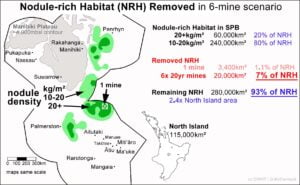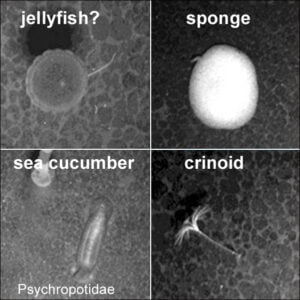Gerald McCormack, Natural Heritage Trust
First published CI News 11 Feb. 2021, last update 23 Mar. 2021.
This article discusses the likely impact of nodule mining on the megafauna associated with nodules in the South Penrhyn Basin (SPB), from Penrhyn southward to Aitutaki and Palmerston. This impact was not among those discussed in the Trust’s 2016 booklet: “Cook Islands Seabed Minerals – a precautionary approach to mining”.
Benthic megafauna is recorded by still photography and video because these animals are larger than four centimetres and they are all visible on or above the seabed. Seafloor or benthic megafauna is divided into two main groups: fast-moving, such as swimming crustacea and fishes; and attached or slow-moving, such as sponges and sea-cucumbers. Here we restrict the term benthic megafauna to attached and slow-moving animals, because these are the megafauna most at risk by removing the polymetallic nodules from the seabed.
Megafauna vs nodule density
Vanreusel et al. (2016)((Vanreusel et al. (2016) Threatened by mining, polymetallic nodules are required to preserve abyssal epifauna. Nature Reports 6:26808)) reported an extensive study of benthic megafauna in the Clarion-Clipperton Zone (CCZ) and we will use it as our baseline. Their results are presented in the graph “Megafauna vs Nodule Density”, where we have combined the attached and slow-moving abundances into a single value for each site.
 Their results in nodule-free or sediment areas showed about 10 individuals/100m², while in adjacent nodule-rich areas megafauna was three times more abundant at 27-35 individuals/100m². The removal of nodules will not only kill the attached and slow-moving megafauna, but it will also destroy their habitat for the foreseeable future.
Their results in nodule-free or sediment areas showed about 10 individuals/100m², while in adjacent nodule-rich areas megafauna was three times more abundant at 27-35 individuals/100m². The removal of nodules will not only kill the attached and slow-moving megafauna, but it will also destroy their habitat for the foreseeable future.
The Vanreusel paper also reported an unexpected result for the CCZ. In a nodule-rich area in the northern APEI (a “preservation area”) there were only four individuals/100m², a mere 13% of the abundance of benthic megafauna on nodules further south in the central CCZ. What caused this dramatic decline?
The insert map shows the location of the areas sampled by Vanreusel along with isolines for POC Flux, which is the quantity of food sinking from the surface waters to feed the animals on the seafloor. The sampled central concessions of IOM, GSR and IFRE had POC Fluxes of 1.5-1.7, which is relatively high and is reflected in the high abundance of benthic megafauna on nodules in the central eastern CCZ.
It is well known that a decrease in POC Flux is associated with a decrease in seabed fauna. However, the decrease to 1.1 in the northern APEI seems too small to fully account for the near demise of the benthic megafauna, unless there was some sort of “tipping point”.
SPB nodules and megafauna
In 2001, Japanese researchers reported a straight 50km video and still photo transect in the nodule-rich Central Area of the SPB((JICA/MMAJ (2001) Report on the Cooperative Study Project on the Deepsea Mineral Resources in Selected offshore Areas of the SOPAC Region, Sea Area of the Cook Islands, Vol. 1. Detailed study of Central Area of SPB along with best data on North and South Areas.)). The transect included 8km of mixed substrate, 20km of hard substrate, and 22km nodule-rich substrate.
Over the whole 50km transect, the attached megafauna was much more abundant than slow-moving animals. Attached megafauna included 593 sponges, along with a few crinoids and sea-anemones, while slow-moving megafauna consisted of 70 sea-cucumbers and 44 starfish.
 Over the 22km nodule-rich section, they recorded 313 attached and slow-moving megafauna, or 14 individuals/km. Assuming the transect was about a metre wide, this gives an abundance of about 0.2 individuals/100m² for direct comparison with the Vanreusel et al. CCZ data.
Over the 22km nodule-rich section, they recorded 313 attached and slow-moving megafauna, or 14 individuals/km. Assuming the transect was about a metre wide, this gives an abundance of about 0.2 individuals/100m² for direct comparison with the Vanreusel et al. CCZ data.
The Megafauna vs Nodule Density graph includes the SPB megafauna abundance of 0.2 individuals/100m² on the left side. It is almost too small to register; it is a mere 0.7% of the nodule-rich areas in the central CCZ of around 30 individuals/100m².
The central SPB benthic megafauna on nodules is 5% of the very low abundance in the CCZ northern APEI of four individuals/100m². This is consistent with the great difference in POC Flux: 0.5 in the central SPB vs 1.1 in the northern CCZ APEI.
There is another interesting outcome of the Vanreusel study, because the Cook Islands CCZ concession is between the GSR and IFRE sites. We can therefore predict that the Cook Islands CCZ concession will have a nodule-rich megafauna of about 30 individuals/100m², which is 150 times greater abundance than in the nodule-rich areas of the SPB.
It follows that the amount of nodule-associated megafauna destroyed by mining in the Cook Islands CCZ concession would be immense compared to the amount destroyed by mining in the SPB.
Benthic megafauna distribution
In the Cook Islands, nodule-dependent megafauna has an immense habitat area and only a small percentage of that habitat will be destroyed by mining.
Deep seabed nodule mining will be limited in both quantity and duration. Cook Islands nodules would be mined primarily for cobalt and secondarily for their nickel and copper, while the opposite is the case for CCZ nodules.
The world demand for cobalt required to make deep seabed mining economically viable is such that more than two or three mines would probably depress the world price enough to make mining uneconomical. Furthermore, the high demand for cobalt, mainly for vehicle batteries, is predicted to significantly reduce as recycling increases and deep seabed mining would become uneconomical in about forty years. Combining these two limitations means Cook Islands nodule mining in the SPB is likely to be limited to a total of six 20-year mines, with a maximum of three at any one time.
In the densest nodule areas of over 20kg/m² each 2.5Mdt/y mine of 20 years would clear 3,400km² of nodules (Hein et al. 2015)((Hein, J.R., Spinardi, F.S., Okamoto, N., Mizell, K., Thorburn, D., and Tawake, A., 2015. Critical metals in manganese nodules from the Cook Islands EEZ, abundances and distributions. Ore Geology Reviews. 68, 97-116.)). Therefore, a total industry of six mines would remove the nodules from a non-contiguous area of about 20,000km² or 1% of the EEZ.
Japanese surveys showed the distribution of nodules by abundance((Clark et al. 1995. Economic and Development Potential of Manganese Nodules within the Cook Islands Exclusive Economic Zone (EEZ). East-West Centrer, Hawaii)). The surveys showed there is about 60,000km² with this very high density of nodules of 20+kg/m², which means that two-thirds or 40,000km² of this area would be unmined and remain available for nodule-associated megafauna. The illustration gives a visual representation of the nodule-cleared area of six mines compared to the nodule-rich area within the SPB.
 A nodule density down to 10kg/m² offers an extensive hard substrate for nodule-associated megafauna. The area with 10-20kg/m² of nodules is about 140,000km² in the SPB, and this would continue to be available for associated megafauna. In total, the undisturbed nodule-rich habitat of 180,000km² remaining in the SPB is immense, about one-and-a-half times the area of the North Island of New Zealand at 115,000km².
A nodule density down to 10kg/m² offers an extensive hard substrate for nodule-associated megafauna. The area with 10-20kg/m² of nodules is about 140,000km² in the SPB, and this would continue to be available for associated megafauna. In total, the undisturbed nodule-rich habitat of 180,000km² remaining in the SPB is immense, about one-and-a-half times the area of the North Island of New Zealand at 115,000km².
Despite the immense nodule-rich habitat that would remain, it is still important to do biological surveys of potential mine sites and the surrounding area to identify the best site for Biodiversity Preservation Areas (BPAs), and to ensure that no species is restricted to a particular mine site. If any such species were found, the mine should move to another area.
I conclude that six 20-year nodule mines in the South Penrhyn Basin are unlikely to have a serious negative impact of nodule-associated megafauna within the Cook Islands EEZ.
Citation
McCormack, Gerald (2021) Nodule mining impact on benthic megafauna. Cook Islands Natural Heritage Trust. https://cinature.org/2021/02/17/nodule-mining-impact-on-benthic-megafauna/
This article has been updated to add a missed 100,000km² of nodule-rich habitat. I have also included new illustrations of the megafauna histograms and of the nodule-rich habitat removed by the 6-mine scenario.
This article was criticised by an anonymous Te Ipukarea Society author (CI News 20 Feb. 2021) and the reply to that criticism is here: https://cinature.org/2021/02/23/anonymous-tis-criticism-misguided/













[…] Assessing impacts on megafauna using a 6-mine scenario. Megafauna & the 6-mine scenario […]